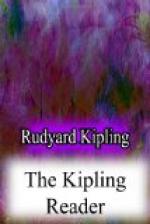I made an attempt that very evening, but for the life of me I could not keep my countenance. Namgay Doola grinned persuasively, and began to tell me about a big brown bear in a poppy-field by the river. Would I care to shoot it? I spoke austerely on the sin of conspiracy, and the certainty of punishment. Namgay Doola’s face clouded for a moment. Shortly afterwards he withdrew from my tent, and I heard him singing to himself softly among the pines. The words were unintelligible to me, but the tune, like his liquid insinuating speech, seemed the ghost of something strangely familiar.
Dir
hane mard-i-yemen dir
To
weeree ala gee,
sang Namgay Doola again and again, and I racked my brain for that lost tune. It was not till after dinner that I discovered some one had cut a square foot of velvet from the centre of my best camera-cloth. This made me so angry that I wandered down the valley in the hope of meeting the big brown bear. I could hear him grunting like a discontented pig in the poppy-field, and I waited shoulder deep in the dew-dripping Indian corn to catch him after his meal. The moon was at full and drew out the rich scent of the tasselled crop. Then I heard the anguished bellow of a Himalayan cow, one of the little black crummies no bigger than Newfoundland dogs. Two shadows that looked like a bear and her cub hurried past me. I was in act to fire when I saw that they had each a brilliant red head. The lesser animal was trailing some rope behind it that left a dark track on the path. They passed within six feet of me, and the shadow of the moonlight lay velvet-black on their faces. Velvet-black was exactly the word, for by all the powers of moonlight they were masked in the velvet of my camera cloth! I marvelled and went to bed. Next morning the Kingdom was in uproar. Namgay Doola, men said, had gone forth in the night and with a sharp knife had cut off the tail of a cow belonging to the rabbit-faced villager who had betrayed him. It was sacrilege unspeakable against the Holy Cow. The State desired his blood, but he had retreated into his hut, barricaded the doors and windows with big stones, and defied the world.
The King and I and the Populace approached the hut cautiously. There was no hope of capturing the man without loss of life, for from a hole in the wall projected the muzzle of an extremely well-cared-for gun—the only gun in the State that could shoot. Namgay Doola had narrowly missed a villager just before we came up. The Standing Army stood. It could do no more, for when it advanced pieces of sharp shale flew from the windows. To these were added from time to time showers of scalding water. We saw red heads bobbing up and down in the hut. The family of Namgay Doola were aiding their sire, and blood-curdling yells of defiance were the only answers to our prayers.
‘Never,’ said the King, puffing, ’has such a thing befallen my State. Next year I will certainly buy a little cannon.’ He looked at me imploringly.




